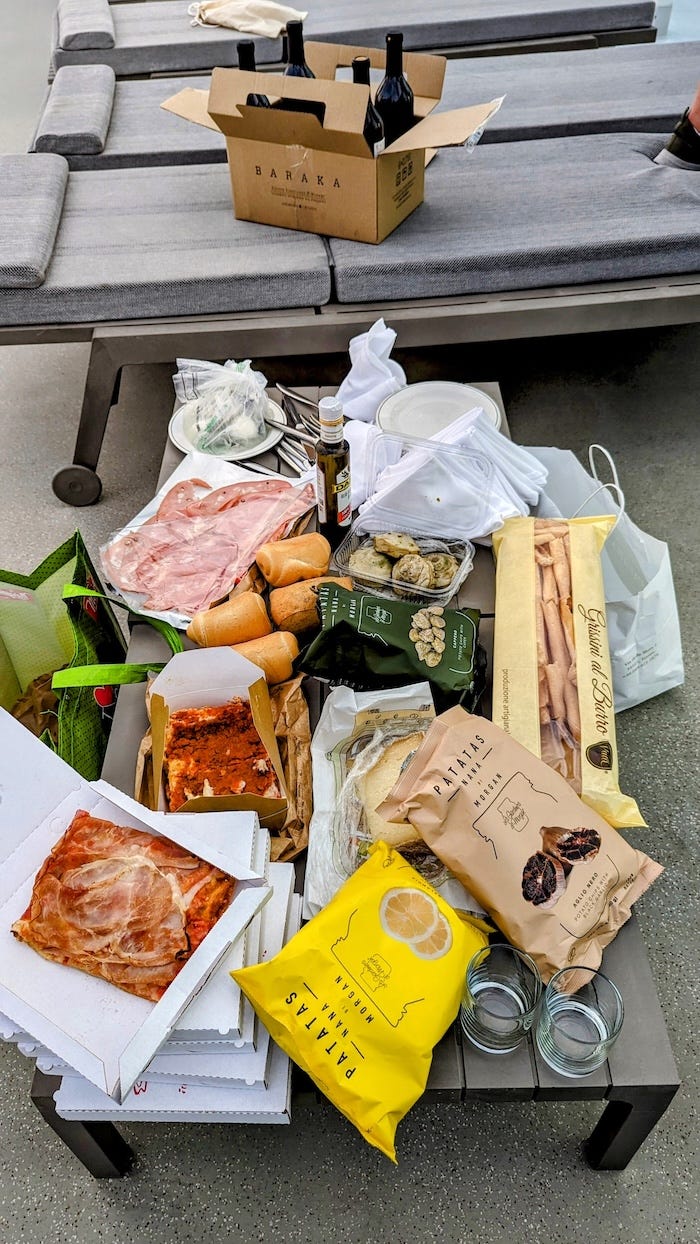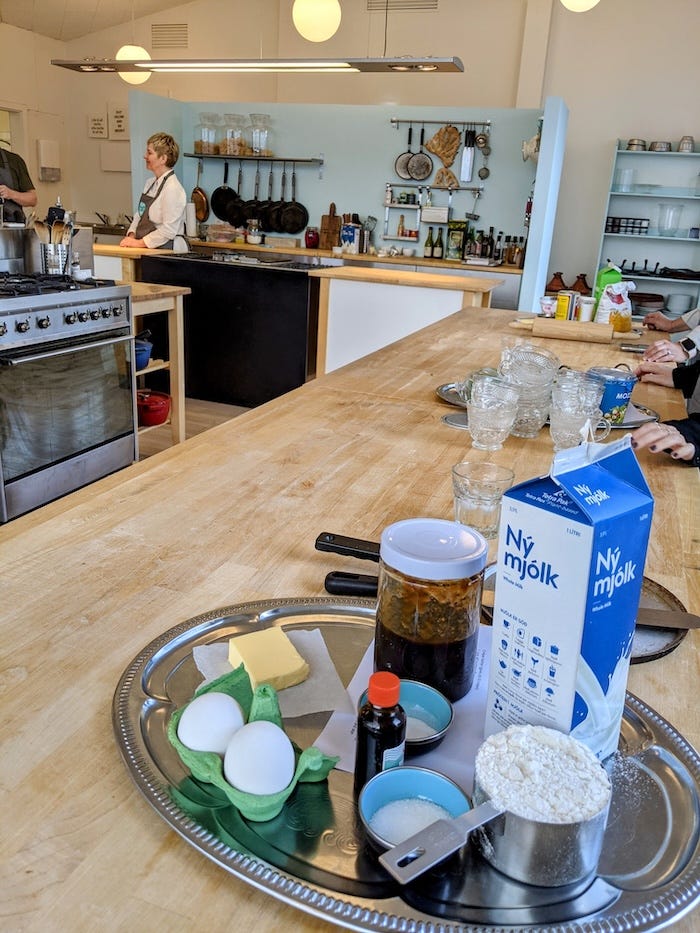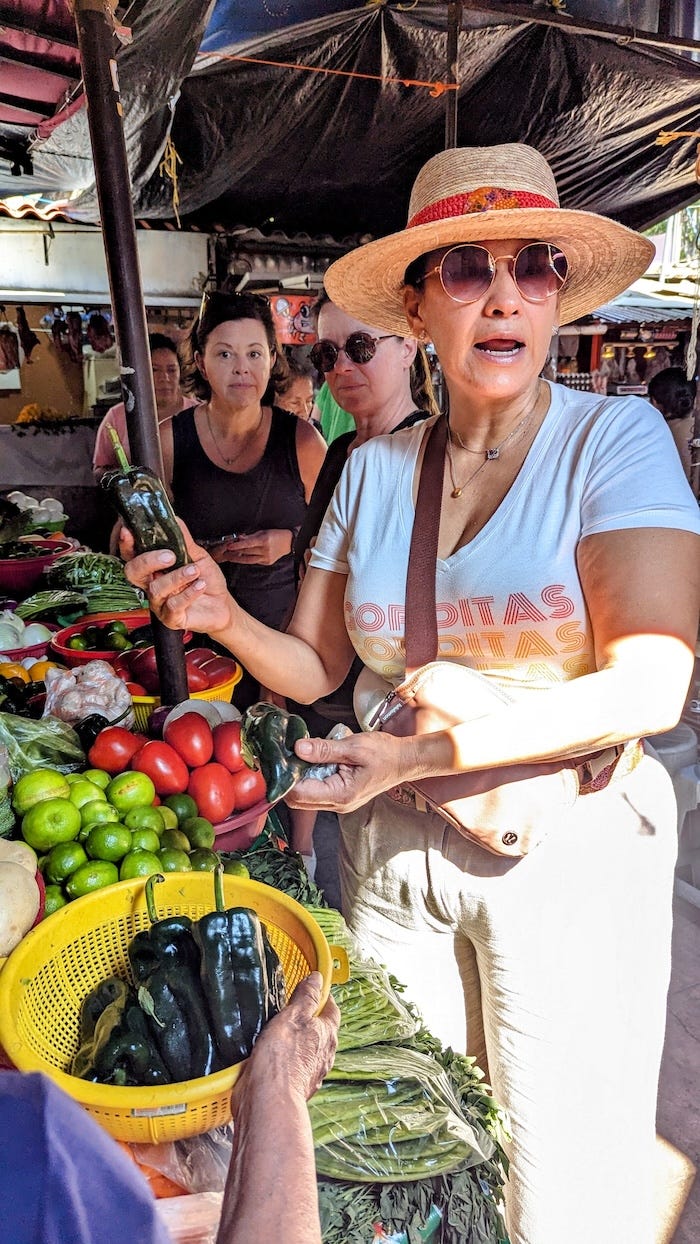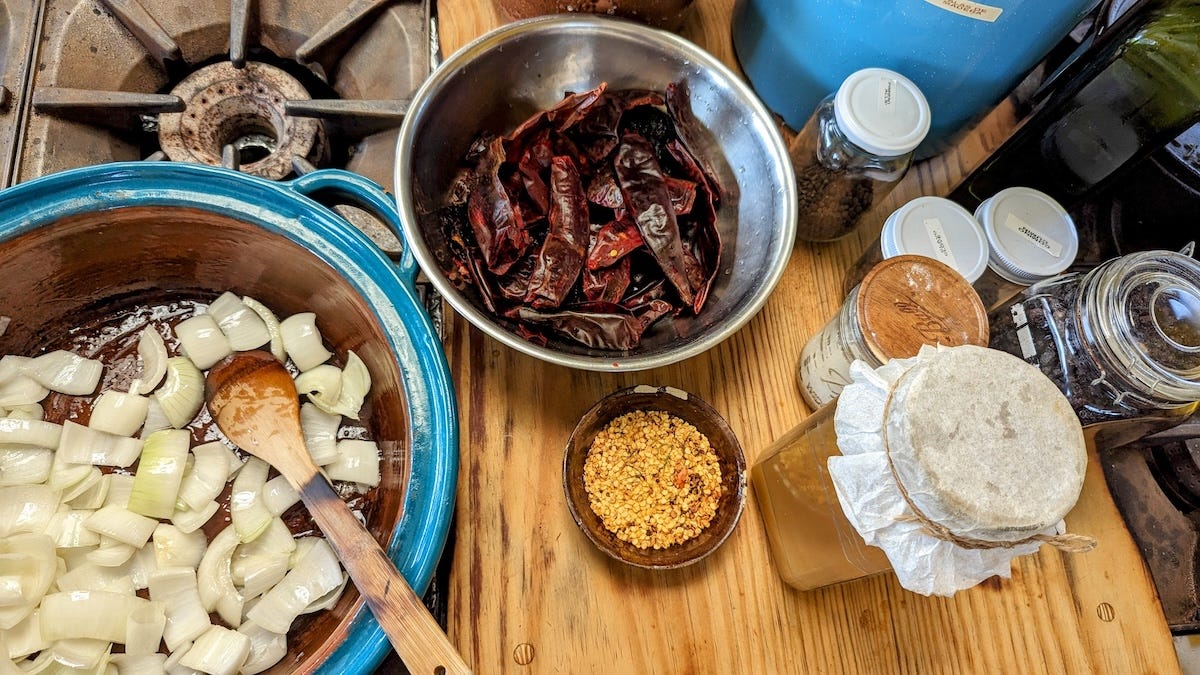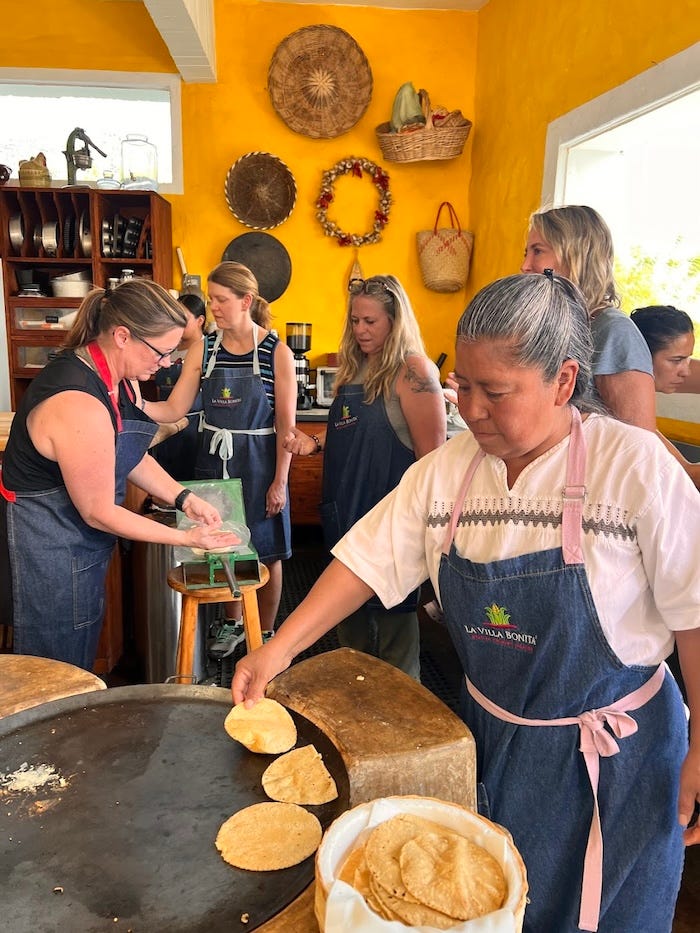Food is a reason to travel. For some of us (ahem) it is THE reason to travel.
It’s not a revolutionary statement to say that the best way to understand a culture is through food. Many travelers are happy to hit up the best restaurants, scoop some local ice cream, find a great bar and call it a day. I need to go deeper.
I love a museum stroll, but it’s equally important to get a grocery store, bodega, or market stroll on my itinerary. You can tell a lot about a people through their snack habits: I’m looking at you Japanese 7-Eleven, and bowing down to your excellence.
On my Amalfi Coast trip last year, as a group we decided to make the last night a picnic of sorts. That allowed us to shop some wine stores, get locally made breads and meats that might never have appeared on a restaurant menu.
The post-Trieste boat picnic in October of ‘23.
But the best way into a culture, is to put your heart in the hands of a local cook. If you don’t have friends you’re visiting, then find a cooking class.
Salt Eldhús
When I went to Iceland in 2021, we landed at Salt Eldhús to learn the ways of dark bread and cold fish. We were lucky to have owner Sigridur Björk Bragadottir, who is an accomplished chef and food writer, show us the ropes. Traditions of Icelandic cooking were discussed with us as we went about the tasks of cooking rye bread in milk cartons and prepping lamb, then we sat around the lunch we has prepared and asked the really deep questions: so how many people are you related to? It’s an island, folks. I learned more about the ancient art of data keeping and how to not date your cousin at that lunch.
I should be honest about something, I love peeping into people’s kitchens about as much as I love eating food. If allowed, I will open all your drawers. Do we all keep our knives the same way? Do you have some special spice stacking tech that I need to know? Is there a worn corner of your cutting board because it’s your favorite spot to chop garlic? You too?
So you can imagine how thrilled I was to be taking a class during my trip to Tepoztlan, in the mountains south of Mexico City. Mexican food is generally under appreciated for its depth and importance (I blame Taco Bell), even though it’s designated as a UNESCO Heritage Cuisine. Plenty of home cooks think that because they can smash some guac together or make a margarita, they know what’s up. Spoiler: there’s more.
We were met by Chef Ana Garcia of La Villa Bonita at the edge of the Tepoztlan market. She asked us if we had any allergies, and then said we’d plan the menu as we go. Walking from stall to stall, she’d chat up the purveyors and point out things we’d never seen like yellow and purple tomatillos. We found her favorite beans, and she threw off a quick tip for making them. We landed at her favorite butcher for chicken, and she told us that she knew these birds had been killed and cleaned just a few hours ago.
We had been to this very market a few days prior, and found it wholly new again under her gaze.
Snaking back and forth, we loaded up the bags she brought, and then made our way out. I should have known, when she got a taxi FOR THE BAGS, what kind of a walk we were in for. Up. On cobblestones. That kind of walk.
Nothing like a good haul to make you hungry! We landed at La Villa Bonita and it instantly felt worth it. Climbing those last few steps to find her sunny yellow kitchen roost felt like a shot of oxygen.
Chef Ana gathered us and told us the house rules (don’t throw trash in what was actually an ice bin, don’t leave the water running while washing your hands, drink lots of water until we get those tamarind margaritas made, etc.). And then she began to tell us about what we were going to cook.
Some of us were on the Chicken in Adobo sauce team, some would tackle tres leches cake, others would make a cheesy poblano sauce for a pasta. There would be margs and tortilla making, plus a salad in the mix as well, but that would be handled as we go.
Team Adobo
We were never handed a recipe card or given strict measurements. Chef Ana trusted us to understand her instruction, and to trust ourselves in what a handful meant or how large a chunk of onion was. This is home cooking. This is how kitchen tradition is passed, not by studying, but by doing.
We snipped and seeded dried chilies, got them into a clay pot where onions, garlic, and lard were already slowly browning, “maybe stop stirring and let them get to where they want to be,” she told me. When one team had reached the end of their instructions, Chef Ana would glide over and impart the next set. She never lost a beat, never raised the tempo, seemed to be everywhere at once with laughter and a strong hand to stir what someone was sheepish about stirring too hard.
It was a kitchen dance, full of stories, full of friends, they way we all wish cooking was like every time we turn the stove on.
The cake team had some time during the bake, so they helped out with poblanos. I don’t even know who made the tamarind margs, but one was thrust into my hands as I was stirring the sauce, “Let it burn a bit! Mexicans love to have a little burn on their vegetables,” Chef Ana chided me.
We took breaks to play with her dogs when we had a lull. I particularly liked staring over the open ledge into the tree tops around us, unless I was snooping her glass-front fridge, or having pantry envy.
Two other women strolled into the kitchen to see what was cooking. They were staying at La Villa Bonita, on the grounds. People come from all over the world to live here for a week or so while learning all they can about Mexican cuisine from Chef Ana. It was a day-off for the two, who had been in the village at a spa, but they were drawn back to the kitchen to see what was cooking. Some others were down in the pool, and I thought: who should I bring back here?
As we were nearing the end of the prep, a few more women came into the kitchen to help us learn how to make fresh tortillas with a press and the large comal built into her cooking island. I may need to return just to practice this art. The grace of their hand flips which landed the thin round dough so perfectly, and the ease by which they plucked one from the hot surface to turn it over, is a practice.
We finished our class with a set lunch on the rooftop, over the kitchen. Chef Ana had invited two of her friends from town to eat with us, and that just opened more doors into the chatter about this magical place we were in. Over the course of that afternoon, the conversation weaved in and out with threads about the local water systems, husbands, herbs, architecture, college-aged kids, the wisdom of lard, and the language of women.
I don’t have a written recipe from La Villa Bonita, but I don’t really want one. I made the Adobo sauce myself this weekend from memory, and in order to learn the secrets of that poblano cheese sauce, I’ll have to have my friends over to teach me what they learned. That sounds like a bit of Tepoztlan magic at work.
If you’re a paid subscriber, keep reading for some travel tips on how to eat street food without fear of losing your guts. If you’re a free subscriber, consider upgrading to paid (just $5/month or $50/year!) to get the goods!
Keep reading with a 7-day free trial
Subscribe to Pickle by Steph March to keep reading this post and get 7 days of free access to the full post archives.






